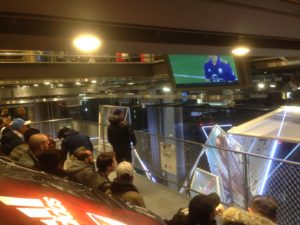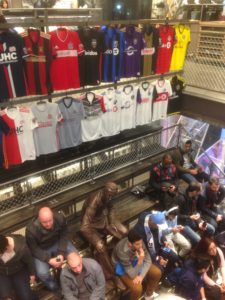Football/soccer is much more than 4-4-2, 3-5-2, 4-3-3, 4-3-2-1 or other systems of play. So, co-branding and co-creation should come natural in the promotional context of making the sport a popular pastime in North America.
Co-branding and co-creation are vital elements in shaping a football/soccer culture on North American soil. The MLS has come a long way since the first game was played in 1996. However, a football/soccer culture is not built overnight in a nation that still climbs to the NFL and the pervasive power of Super Bowl as a national holiday and thus the first-hand expression of the NFL’s strongly established brand equity. Nevertheless, the MLS seems to on a successful mission to vitalize it aspirations to become a “pre-eminent sport in North America” but the timing for the realization of these aspirations is a good question given the competitive forces in the American sports landscape, e.g. the competitive environment filled with other major sports leagues like the NFL, the NBA, the NHL and the MLB.
Photo: Saturday night soccer in Colorado (Colorado Rapids vs. Columbus Crew).
Football/soccer is much more than 4-4-2, 3-5-2, 4-3-3, 4-3-2-1 or other systems of play. So, co-branding and co-creation should come natural in the promotional context of making the sport a popular pastime in North America. This approach should be perceived to be just as ordinary as the understanding among football/soccer enthusiasts that most opportunities on the pitch are created from passes founded on second or third movements instead of passing the ball on the first and most obvious movement. Thereby, the economics of growing the business of the MLS becomes a function of the same cohesion and shared relationships as seen effective on the pitch. When building a #WinningCulture on the pitch, cohesion and relationships among the active parties are essential building stones, e.g. among players within the defensive (including the goal keeper), midfield and offensive lines or between players in different lines, between players and coaches, sporting directors and general managers in relation to matters on and off the pitch. For stakeholders outside the pitch: don’t just buy the exposure or the right to show the game! Engage and be accountable in articulating and growing the game. The US is an outgoing culture and there are always sports on television in bars and restaurants and through other platforms so there are good opportunities for American brands to engage with the domestic and international football/soccer community and with younger generations growing in love with the game. Why not take the responsibility to grow the most popular sport in the world in the North American sports market? Football/soccer is not just a power game like the American NFL. It is a stage of artistry, aesthetics and tactical competence as illustrated by FC Barcelona under coaches like Johan Cruyff and Pep Guardiola. For that reason, the league has a challenge in terms of boosting talent development and to offer the game to the youth population and to young talents all year round. At the same time, the league must diversify its focus from investing in ‘faded’ international stars to applying a more holistic tactic to what is needed to build a sustainable foothold for the game, e.g. participation rates, fan interest, sponsor opportunities and media appeal. The performances of international stars like David Villa and Sebastian Giovinco are good examples of players that came to the MLS with the intention to improve the league.
Video: Activation of star player David Villa to fans of the future.
The co-branding dimension is relevant to consider in this context. The economics of co-branding propose that the purpose of branding is to create value (also from a financial perspective). Co-branding helps to manifest this purpose by integrating an important ‘win-win scenario’ founded on the premise of constructing synergetic effects through the process of brand building and brand management (Blackett & Russell, 1999; 2000).
Of course, this is a simplified elaboration of how to define co-branding and how to apply the concept in the business of sports. For that reason, it is significant to emphasize that innovation and creativity become decisive elements concerning how co-branding can assist practitioners in the business of the MLS? In answering that question, co-branding should raise the question of how the involved partners’ modifications of their value chains in order to produce mutual branding benefits and brand equity are strategically aligned. The resources for better co-creation processes and thus enhanced brand interactions are improved if these modifications are optimized. That illustrates the economics of co-branding by creating better ‘shared economic value’ that can reinforce the brand building and brand management direction of the MLS. This direction can beneficially be framed towards my interpretation of Prahalad’s (2004) five suggested areas for value creating co-creation:
1) There are many ways in which MLS stakeholders (e.g. teams and sponsors) can create a good engagement of their target audiences. In a co-branding context, sports sponsorship incorporates paths for convincing and persuading the target audience, e.g. fans, through the implemented promotional activities. In that sense, the process constitutes a dialogical and interactionist approach aimed at the formation of a shared meaningful understanding, which demonstrates that rights holders and sponsors can offer something ‘good’ in shared fashion. The engagement of customers, e.g. fans, should be at the heart of ‘emotional equity’ in the form of the emotional engagement and there is room for co-production in this process just like that is the case for physical engagement of customers.
Video: Football/soccer fan culture is on the rise in the MLS.
Video: Adidas promoting CSR in the MLS.
2) Involvement of the customers, e.g. fans, can be created via ‘self-service’. For instance, sports teams apply this by offering fans ‘self-check-in’ by the use of their cell phones at the venue. In sports sponsorship, this offers a good way for sponsorship integration. For instance, Major League Soccer’s partnership with SeatGeek offers a new ticket buying experience through which fans can approach game experiences in an new manner via a mobile-focused experience that allows fans to buy, sell and send tickets to friends across any device while allowing fans to simply scan their ticket into the game by the use of their phone. Within the collaborative context of sports teams and technology suppliers, there are many opportunities for co-creation and co-branding in which the transfer or working processes and knowledge take place in the cycle between the league, its teams, sponsors and fans and thus contribute in creating value for all parties.
Photo: Technology such as SeatGeek’s Pano 360-degree maps is a co-branded example of pushing the junction between the MLS and technology.
3) Make sure to set the framework conditions for good (customer and fan) experiences in close collaboration with the sponsors while allowing your customers, e.g. fans, to be a part of these experiences. For instance, Disney fascinates Manchester Citys CEO Ferran Soriano, check this article, which exemplifies an entertainment brand that excels in building great customer experiences.
Photos: The Adidas store on 5th Avenue in NYC offers football/soccer fans an interactive game experience in relation to the season opener of the 2017 MLS season.
4) The business of sports has moved towards more fan involving dialogues and this direction is important. In the intersection between rights holders, sponsors and customers, e.g. fans, this dialogue can beneficially be staged with the inclusion of resources from involved partners to solve actual challenges. For the MLS, it would make sense to include partners to solve the challenge of moving up the ladder in the professional American major league sports hierarchy, i.e. growing television ratings, attendance figures and total revenue generation to gain a better foundation for re-investments in football/soccer. In the execution, it is vital to establish some positive points of differentiation, which build an effective bridge between strategic focus and timely and meaningful operationalization.
Photo: New York City FC is strategic about highlighting the importance of the club’s meaning for NYC.
5) The above-mentioned fan involving dialogues and the execution with problem solving as a central focal point require involvement from all parties in an authentic way, and the new risk-, work- and service- distribution creates ownership for all parties, which with all other things being equal (some economists would call this a ‘ceteris paribus’ perspective) can create good economic value. Co-design is put in play. This is associated with the understanding of why and how there in a traditional economic terminology (Vargo & Lusch, 2004) exists a transfer of value. For that reason, modern sponsorship and sports business growth perceptions should integrate a thought process in which the dominating negotiation of meaning is not only characterized by tangible resources, incorporated value and physical transactions but also includes intangible resources through which value creation takes place via co-creation and relationships. This leads to essential emphasis on tendencies from the experience economy and the transformation economy (yes, business is a ‘two-way street’ and sponsorship is an interesting field) that highlight the importance of creating positive disruptions for the customers, e.g. fans, by containing these stakeholders in the process. Some rights holders may have reservations concerning this approach. Therefore, it makes sense to underline that they can still maintain a good level of managerial control in the process.
The five factors are aligned with my perception of sponsorship as a strategic marketing platform. From a research angle (Urriolagoitia & Planellas, 2007; Cortsen, 2015; 2016) and concerning practice-oriented implementation as a promotional tool, sponsorship should be understood as strategic alliances, which benefit from the inclusion of significant resources from all involved parties. Of course, it serves a point to emphasize that it is meaningful that the customers, e.g. the fans, have found new ways in which they engage with sports properties, e.g. see this example. These engagement pathways include considerations regarding the technological and digital development (including social media tools), the fan-generated demand for pervasive ‘connectivity’ in relation to information, network and other relevant content and the intersection between globalization and ‘localized content’ (remember that sports are very dependent on local, regional and/or national manifestation).
Video: New York City FC and ‘localized content’.
Based on knowledge that sports and entertainment valuably should be perceived as interrelated market places, it becomes essential to integrate relevant market segments in the value creation process. Thus, the outcome becomes value creation through co-creation and co-branding. Stakeholder experiences in the MLS are lifted due to the co-creation and co-branding, which supports my suggestion (Cortsen, 2015) regarding dialogical partnerships through which there are platforms that facilitate access to and transparency concerning information and risk management (what happens if the challenge, cf. the above-mentioned item 4, is not solved?). However, it should be recognized that it may be a good idea to include more than one sponsor to create ideal co-creation and co-branding initiatives to optimize the comprehensive football/soccer experiences (keep the famous sports analogy ‘there are competitions within the competition’). There are several concrete suggestions in this regard but why empty my brain totally as my suggestions always will be situational based on the insight that brand interactions cannot be detached or isolated from time and context. Brands must be something essential for people right here and right now!
Great hospitality experience by the @MLS @Gaetjens let’s see what @Pirlo_official & @Guaje7Villa can do #NYCFC pic.twitter.com/5YRlXsqXr3
— Kenneth Cortsen (@kennethcortsen) March 13, 2016
Video: New York City FC reflecting local identity.
Video: the importance of rivalries for the vitality of football/soccer fan culture (Seattle Sounders vs. Portland Timbers).
Video: Football/soccer team fan motivation.
References:
Blackett, T., & Russell, N. (1999). What is co-branding?. In Co-Branding (pp. 1-21). Palgrave Macmillan UK.
Blackett, T., & Russell, N. (2000). Co-branding—the science of alliance. Journal of Brand Management, 7(3), 161-170.
Cortsen, K. (2015). Capitalising on CSR-based partnerships in sports branding and sports sponsorship. International Journal of Sport Management and Marketing, 15(1-2), 75-97.
Cortsen, K. (2016). Strategic Sport Branding at the Personal, Product and Organizational Level. Doctoral dissertation, Aarhus University.
Prahalad, C. K. (2004), The co-creation of value, Journal of Marketing, 68 (1), 23.
Urriolagoitia, L. & Planellas, M. (2007). Sponsorship relationships as strategic alliances: A life cycle model approach. Business Horizons, 50(2), 157-166.
Vargo, S. L., & Lusch, R. F. (2004). Evolving to a new dominant logic for marketing. Journal of marketing, 68(1), 1-17.





COMMENTS
No comments yet.